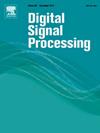用于抑制中断采样中继器干扰的可解释 ADMM-CSNet
IF 2.9
3区 工程技术
Q2 ENGINEERING, ELECTRICAL & ELECTRONIC
引用次数: 0
摘要
中断采样中继器干扰(ISRJ)是相干干扰的一种,对雷达的探测性能有很大影响。由于 ISRJ 比真实目标的功率更大,因此 ISRJ 信号可以在时域中去除。由于频带损耗,如果直接进行脉冲压缩(PC),就会产生光栅裂片,从而产生假目标。压缩传感(CS)是恢复原始 PC 信号的有效方法。然而,在不同的 ISRJ 背景下,手动选择优化参数(如惩罚参数、步长等)对经典 CS 方法来说是一项挑战。本文引入了一种基于交替方向乘法(ADMM)的网络方法来解决这一问题,命名为 ADMM-CSNet。基于深度网络的强大学习能力,ADMM 中的所有参数都是利用反向传播从雷达数据中学习的,而不是传统 CS 技术中的手动选择。与传统的 CS 方法相比,该方法能更快地达到更高的 ISRJ 消除信号恢复精度。仿真实验表明,该方案能有效、准确地重建 ISRJ 消除信号。本文章由计算机程序翻译,如有差异,请以英文原文为准。
Interpretable ADMM-CSNet for interrupted sampling repeater jamming suppression
Interrupted sampling repeater jamming (ISRJ) is a category of coherent jamming that greatly influences radars' detection performance. Since the ISRJ has greater power than true targets, ISRJ signals can be removed in the time domain. Due to frequency band loss, grating lobes will be produced if pulse compression (PC) is performed directly, which may generate false targets. Compressive sensing (CS) is an effective method to restore the original PC signal. However, it is challenging for classic CS approaches to manually select the optimization parameters (e.g., penalty parameters, step sizes, etc.) in different ISRJ backgrounds. In this article, a network method based on the Alternating Direction Method of Multipliers (ADMM), named ADMM-CSNet, is introduced to solve the problem. Based on the strong learning capacity of the deep network, all parameters in the ADMM are learned from radar data utilizing back-propagation rather than manually selecting in traditional CS techniques. Compared with classic CS approaches, a higher ISRJ removal signal restoration accuracy is reached faster. Simulation experiments indicate the proposal performs effectively and accurately for ISRJ removal signal reconstruction.
求助全文
通过发布文献求助,成功后即可免费获取论文全文。
去求助
来源期刊

Digital Signal Processing
工程技术-工程:电子与电气
CiteScore
5.30
自引率
17.20%
发文量
435
审稿时长
66 days
期刊介绍:
Digital Signal Processing: A Review Journal is one of the oldest and most established journals in the field of signal processing yet it aims to be the most innovative. The Journal invites top quality research articles at the frontiers of research in all aspects of signal processing. Our objective is to provide a platform for the publication of ground-breaking research in signal processing with both academic and industrial appeal.
The journal has a special emphasis on statistical signal processing methodology such as Bayesian signal processing, and encourages articles on emerging applications of signal processing such as:
• big data• machine learning• internet of things• information security• systems biology and computational biology,• financial time series analysis,• autonomous vehicles,• quantum computing,• neuromorphic engineering,• human-computer interaction and intelligent user interfaces,• environmental signal processing,• geophysical signal processing including seismic signal processing,• chemioinformatics and bioinformatics,• audio, visual and performance arts,• disaster management and prevention,• renewable energy,
 求助内容:
求助内容: 应助结果提醒方式:
应助结果提醒方式:


